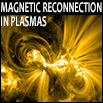Speaker
Yann Pfau-Kempf
(Finnish Meteorological Institute, Helsinki, Finland)
Description
The Finnish Meteorological Institute's hybrid-Vlasov model
Vlasiator
(http://vlasiator.fmi.fi), which couples kinetic ion physics
through Vlasov's
equation with charge-neutralising fluid electrons, is used to
model self-consistently
the solar wind-magnetosphere interaction in two spatial and
three velocity
dimensions. Recent simulations in the polar plane include
southward IMF in a box
extending from about 40 Earth radii (RE) upstream in the
solar wind to about one
hundred RE downstream, thus covering the dayside and
nightside reconnection sites in
a single simulation volume. Dayside reconnection at the
magnetopause results in the
formation of the two-dimensional equivalents of flux transfer
events. These magnetic
islands are accelerated and move from the subsolar region
towards the cusps and
beyond. In doing so, they generate fast-mode waves which
propagate throughout the
magnetosheath and can lead to significant perturbations in
the bow shock shape and
position. We investigate such simulated events and their
possible signatures in the
magnetosheath, at the bow shock and in the foreshock.
Author
Yann Pfau-Kempf
(Finnish Meteorological Institute, Helsinki, Finland)
Co-authors
Arto Sandroos
(Finnish Meteorological Institute, Helsinki, Finland)
Heli Hietala
(Imperial College, London, UK)
Minna Palmroth
(Finnish Meteorological Institute, Helsinki, Finland)
Otto Hannuksela
(Finnish Meteorological Institute, Helsinki, Finland)
Rami Vainio
(University of Turku, Turku, Finland)
Sanni Hoilijoki
(Finnish Meteorological Institute, Helsinki, Finland)
Sebastian von Alfthan
(Finnish Meteorological Institute, Helsinki, Finland)
Urs Ganse
(University of Helsinki, Helsinki, Finland)

